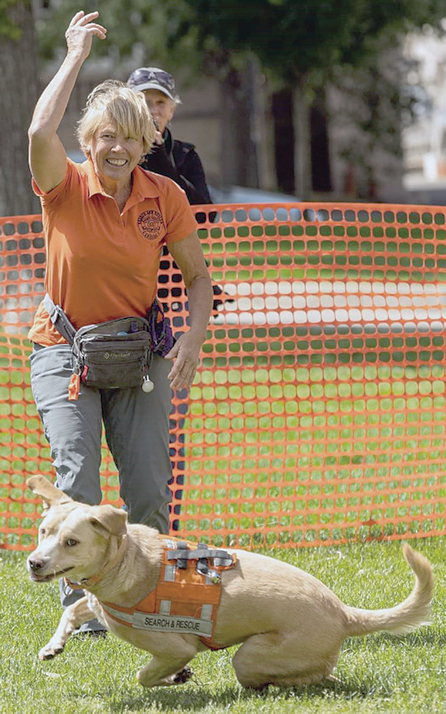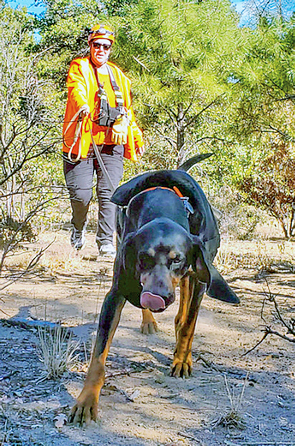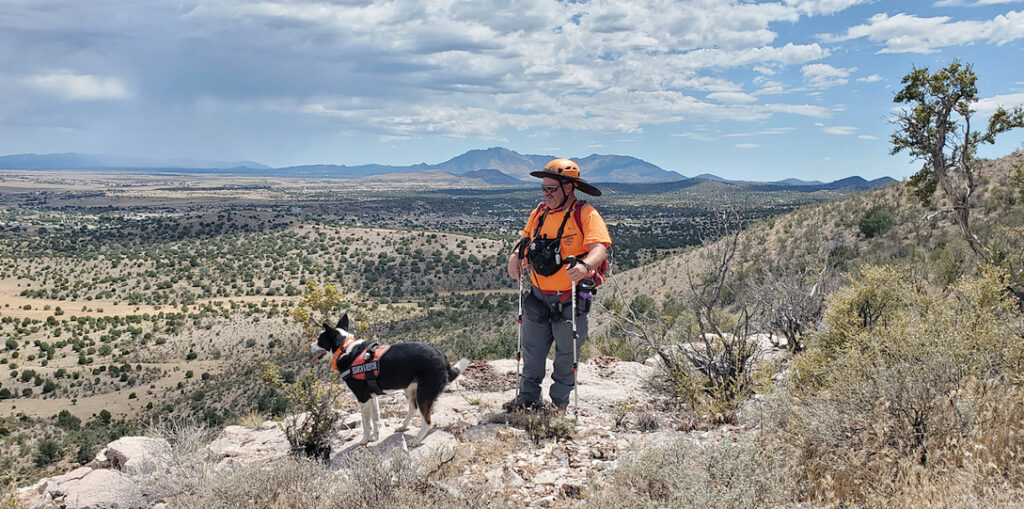In Yavapai County, Rescued Dogs are Now Helping to Rescue Lost People
By Heidi Dahms Foster
The Yavapai County Sheriff’s Office has recently reorganized its Search Dog Unit, bringing it into compliance with State and National training and certification. “The Sheriff’s Office wanted to get the dog unit to a place where we take the right steps from beginning to end, from training and testing statewide and nationally to doing searches,” said Patricia Richardson, who is the public relations volunteer for the group as well as a “flanker,” the person who accompanies and assists a handler and dog team.

The unit is part of the larger Yavapai County Search and Rescue Team that includes Backcountry, Quad, 4×4, Fire Observers and a Southern Unit. The Search Dog Unit currently has 11 canine members, most of them rescue dogs of all different breeds. The team includes a Border Collie mix, two Lab mixes, a German Shepherd, two Coonhounds; a German Shepherd Chow mix, an Australian Shepherd mix and the Richardsons’ Belgian Malinois, Scout. As each dog joins the team, they find their niche in one of the search categories.
Patty said being a part of this team is one of the most exciting things she has ever done, other than raising her children. “It’s fulfilling, and I’m learning a lot. I used to get lost in a paper bag, and now I’ll never get lost again!”
The YCSRT dog team trains three times a week – one time with just the human members drilling on compass, and GPS, what Patty calls “not getting lost skills.” The other two days are spent with the dogs both on weekdays and weekends to accommodate members who work.
The K9 unit has three types of dogs, she said. Trailing dogs are trained to follow a specific human scent, which may or may not approximate the path the person took. A trained trailing dog can follow the steps of someone who passed by several days earlier, discriminate between it and another’s trail. An air scent dog takes the odor from the air to find a person. They don’t need a “last seen” starting point, an article to work from or a scent trail, and time is not an issue and human remains detection dogs scent people who are deceased. They can locate entire bodies (including those buried or submerged), decomposed bodies, body fragments (including blood, tissues, hair, and bones), or skeletal remains.

Each dog/handler team has a “flanker,” another person who goes out with the team for safety. The flanker helps navigate, use the radio and watches to see what’s ahead as the handler watches the dog. The flanker is also another set of eyes on the dog to help watch for the body and demeanor changes that signal an alert. Patty said the team always needs more flankers, people who may want to volunteer but don’t have a dog.
The YCSRT teams assists with more than 95 searches per year, everything from people with dementia who become lost, to hikers who find themselves lost or injured. The K9 team works with all of the other units, depending on what the search requires.
When the Sheriff’s Office receives a lost person call, a Sheriff’s deputy in charge will evaluate to see what resources are needed. If it is something that cannot be handled by personnel on duty, then search and rescue units are called in, depending on the situation.
“Maybe it’s just someone broke down on a trail, and YCSO can just send the Quad or 4×4 Unit, said Mark Richardson. “If it’s a lost person, it’s all hands on deck, and all the units are called out and assigned a place to search, depending on what type of terrain it is. Everyone has a job.”
Incident Command assigns each unit an area to search, he said. “We take our dogs to the area, and we may send the trailing dogs from the last known location of the person. If someone says they saw the lost person in an area, we may send the air scent dogs. We do a grid search of the area, divided into zones that are 40 to 60 acres. Each zone is given to a dog team and we search that area. If there is a person in that area, our dogs will find them,” he said. “It may not be the lost person, but our dogs will tell us, maybe it’s another hiker, then we’ll move on.”
If the team is searching for what the Sheriff thinks may be a deceased person, such as a cold case search, the human remains dogs will be sent in to find the body. These dogs have such a refined sense of smell that they can detect a buried person, or a body in water, because gases rise to the surface. In these cases, a dog may scent a body from a boat, and then divers are sent in.
“These dogs will go right past a dead deer, but they’ll find a human. Sometimes criminals will hide a body under animal remains, but the dog knows the difference,” Mark said. “I train my dog to look under dead or decaying animals during a search.”
Solid basic obedience training is crucial for search and rescue dogs. The trailing dogs search on a 20-foot lead line, with the handler and flanker following. But the rest of the dogs are off lead and range as much as 25 yards in front or to the side of the handler. The Air Scent dogs will find a lost person and return to the handler at a run, then sit in front of them facing in the direction of the person they have found. In Mark’s case, Scout “will look at me and bark, then he runs back to the lost person until we get there. Once he finds a person, he’ll go up and nudge them and then return to me. He doesn’t sit with the person.”

When a person is found, Patty said, that’s when the flanker gets more involved. The flanker takes care of the lost person, assesses injuries and renders first aid if needed as well as radio in to the command post that the lost person is found. Each person on the team is instructed, tested and certified on a state and national level in first aid and CPR on a regular basis.
Not only do the dogs need to be well trained and healthy, the handlers have to pay attention to their own health and stamina. “We train three times a week,” Patty said. “We have to stay in shape.” Age is not a problem, she said, as one of search & rescue’s top members is 80 and a legend in wilderness survival. Members must be able to travel two miles in one hour on a flat surface with a 25-lb. pack. They are tested every two years.
Special care is taken for the dogs. “Our dogs are only good for about an hour, then they need to take a break, and let another team continue the search. We don’t overwork our dogs – searching is exhausting,” she said.
Patty enjoys watching the dogs do their job. As soon as the vest comes out, she said, the dogs know they are going to work. It’s all a big game to them – they are reward driven and they get excited to go out.
“I literally knew nothing – no compass, no GPS, how dogs’ noses work,” Patty said. “It has been a wonderful journey and learning experience for me.” YCSRT teaches all their members these tools.
The social and service aspect of the team has also been gratifying to Patty. “We have a wonderful team we all get along very well. It’s a team effort. Our lead trainer, Heather Lum, is amazing. She comes from a longtime search and rescue background in Pennsylvania. Our Unit Manager, Kathy Blanco, is a retired nurse.”
Patty said the K9 team can always use a few good new members. Applicants will first be evaluated by the team manager and lead trainer to see if they and their dog are suitable for search and rescue.
A dog suitable for search and rescue must have play drive, being rewarded with a ball or treat. More flat-faced dogs are generally not suited for SAR as they can have breathing problems in a search environment. The dogs must be agile enough to jump up on rocks and navigate rough terrain. All must complete Canine Good Citizen training. They need to have a solid recall, and be able to sit, stay and obey commands off lead. They are there to do a job, Patty said, and can’t take off and chase a rabbit when they like.
Those who may want to look further into search and rescue can go to the Yavapai County Search and Rescue website at ycsrt.org to get information. Contact information is on the site.


